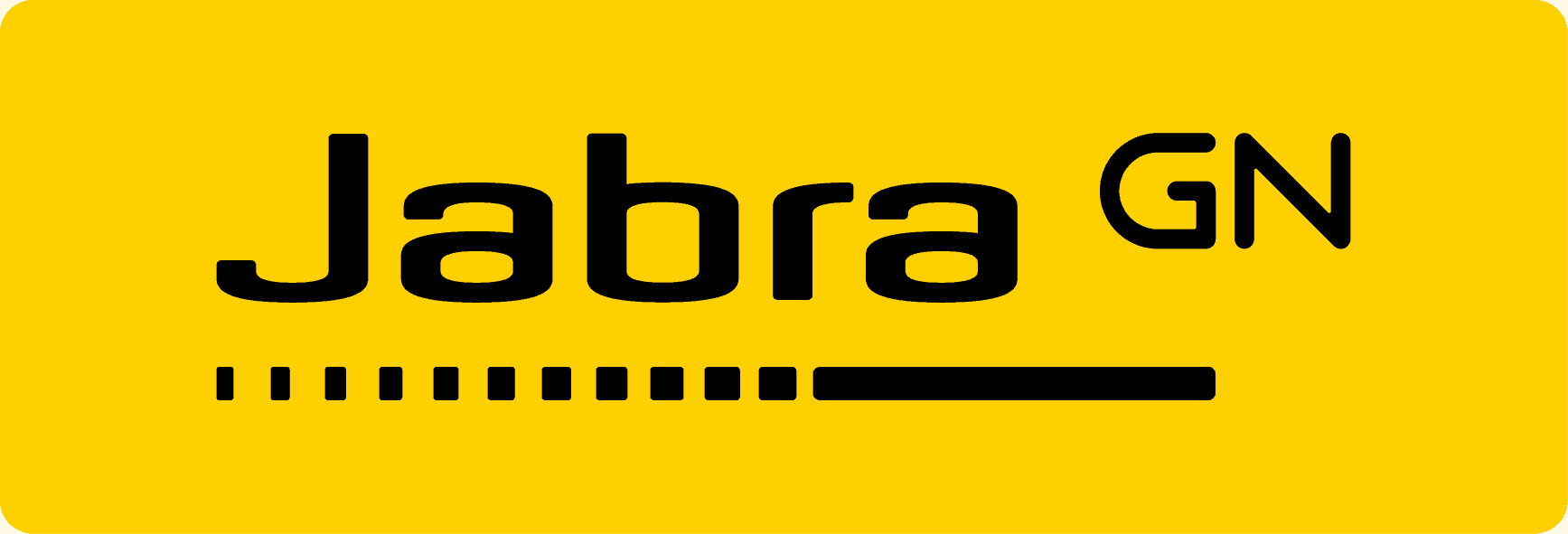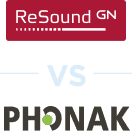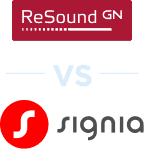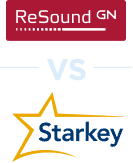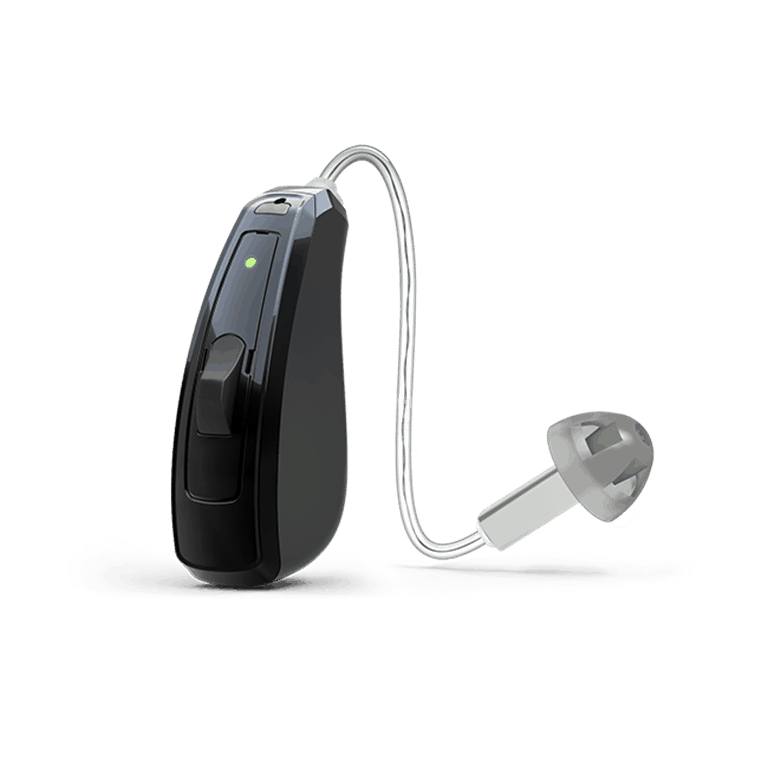
ReSound Hearing Aid Review: (Audiologist Tested)


I have worked with Resound since I was an Audiology resident at a VA hospital. Shortly after that, Resound released the Linx, the first-ever made-for-iPhone hearing aid. I remember the first time a patient recounted to me the joy of not struggling to hear on a phone call. Since this impressive innovation, I have continued to follow or fit their technology.
ReSound is known for being the first hearing aid manufacturer to include direct-to-iPhone streaming in its hearing aids. As communication becomes increasingly dependent on internet-equipped smart devices, hearing aids with the 2.4 GHz technology continue to rise in popularity and have been adopted by other hearing aid brands, but ReSound continues to be at the forefront of wireless technology and direct connectivity.
Did You Know: Our top-rated Jabra hearing aids are made with ReSound technology? If you want ReSound quality that requires no prescription, then check out our Jabra Enhance hearing aids review.

Our Top-Rated OTC Brands
While ReSound hearing aids performed well in our tests, they can easily cost upward of $5,000 for a pair, not to mention they require in-person audiologist visits. If you have mild to moderate hearing loss, then one of these three hearing aid brands might be right for you. Each of them offers devices for under $1,5000 for a pair.
Pros and Cons of ReSound Hearing Aids
Before we dive into the nitty-gritty, here are my main takeaways when it comes to ReSound hearing aids.
ReSound Pros
- Auracast compatibility: ReSound is one of two hearing aid companies that create Auracast devices, allowing users to stream audio directly from Auracast compatible devices.
- Advanced Noise Reduction: Through a combination of advanced software algorithms, ReSound hearing aids can reduce noise from wind, outside conversations, and general ambient noise, allowing you to focus solely on what you want to hear.
- Audio Streaming: Resound has been a leader in audio streaming technology. Most ReSound hearing aids are constructed with made-for-iPhone technology, allowing you to seamlessly pair your hearing aids with your smartphone. Increasingly, its wireless streaming is also compatible with Android phones. With their ReSound Smart 3D app, your hearing aids can pair with just about any smartphone, so you can make volume and program adjustments (but you might not be able to stream audio if the phone is not compatible, it’s best to check).
- Directional Microphones: Using at least two microphones in most of its models, ReSound hearing aids give you access to more than merely the noise in front of you (just like your ears) allowing you to choose what sounds you wish to hear.
ReSound Cons
- Must Be Professionally Fitted: Unlike direct-to-consumer hearing aids, ReSound’s devices must be purchased from a licensed hearing care professional. While these hearing health professionals will ensure you’re matched with an appropriate device, the whole process will take a bit longer than simply ordering online.
- Less Affordable: Averaging about $2,000 to $6,000 per pair, ReSound hearing aids are far from cheap, despite their stellar quality.
ReSound Hearing Aid Models
Currently, ReSound offers several different models of hearing aids, several of which are available in multiple styles and fits.
A Note on Numbers: In addition to the specific model, most ReSound models are available in different technology levels.You’ll usually see a 5, 7, or 9 after the name, with nine being the most high-tech.
ReSound is continually innovating and releases new hearing aid styles frequently. In the last several years, they have released:
- 2023: Nexia
- 2022: OMNIA
- 2021: Key
- 2020: One
- 2019: ENZO Q
- 2018: LiNX Quattro
ReSound Nexia, their latest model, is available in many different styles: behind-the-ear (BTE), receiver-in-canal (RIE), and custom in-the-ear aid. All Nexia products are Auracast-compatible. The Nexia Micro RIE, the most popular style, features directional microphones on the body of the hearing aid, and an additional microphone inside the ear canal, allowing for a more natural replication of sounds. This receiver-in-canal hearing aid also features an advanced speech understanding feature, allowing you to tune out background noise in tough environments. These hearing aids also come with a handy charging case (á la Apple’s AirPods) that can provide up to three days of charge on the go.
ReSound’s LiNX Quattro is still in production and a solid hearing aid choice. Although it will lack the most advanced sound processing and Auracast capability of the Nexia, it’s a good hearing aid choice at a lower price. The collection of hearing aids is available in all styles and delivers wide-ranging connectivity. The RIE style has a long-lasting rechargeable battery life, all without sacrificing a sound quality that is as clear as it is dynamic. Available in receiver-in-canal, custom, and behind-the-ear styles, this hearing aid is ideal for those with mild to severe hearing loss.
For those with severe-to-profound hearing loss, ReSound’s ENZO Q series provides crystal-clear audio while drowning out excess noise. This behind-the-ear model has excellent feedback cancellation to eliminate the whistling often found in profound loss solutions. It can also pair with iOS and many Android devices for direct audio streaming. Introducing direct phone streaming to my patients with severe-to-profound loss is one of my favorite things to do. At their first follow-up appointment, they often recount how for the first time in years, they did not have to hand the phone to their partner to take the phone call for them. The ENZO is also compatible with cochlear implants from Cochlear, which means that the hearing aid and implants can communicate with each other, and you can stream to both at the same time.

FYI: For a rundown of our favorite hearing aids, check out our most recent rankings.
Cost of ReSound Hearing Aids
Since hearing aid manufacturers do not sell directly to consumers, they typically do not put prices on their websites. Pricing information is sometimes available from distributors that provide hearing aids directly to the end-user. Generally speaking, prices for ReSound hearing aids may range from $1,500 to $3,500.
Many different factors can affect pricing, including the model you require, the variety and style you choose, and the audiologist from whom you receive your hearing aids. The following pricing information should be regarded as an approximation that may vary among different distributors.
ReSound Hearing Aid Comparison
| ReSound Nexia | ReSound LiNX Quattro | ReSound ENZO Q | ReSound LiNX 3D | ReSound ENZO 3D | |
|---|---|---|---|---|---|
| Cost | $3,358 | $2,476 | $2,380 | $2,299 | $1,699 |
| Style | Receiver-in-canal | Receiver-in-canal , behind-the-ear, or custom style | Behind-the-ear | Receiver-in-canal | Behind-the-ear |
| Bluetooth Connectivity | Yes | Yes | Yes | Yes | Yes |
| Battery Type | Rechargeable | Rechargeable or Disposable | Disposable | Rechargeable or Disposable | Disposable |
| ReSound Smart 3D App | Yes | Yes | Yes | Yes | Yes |
| Level of Hearing Loss | Mild to Moderate | Mild to Moderate | Severe to Profound | Mild to Moderate | Severe to Profound |
| Unique Features |
|
|
|
|
|
How to Purchase ReSound Hearing Aids
To purchase ReSound hearing aids, you’ll want to start by visiting their website. Here, you can take a free online hearing assessment and then search for a hearing care professional in your area. Since ReSound products must be purchased through a hearing professional, you’ll need to set up an appointment for further testing before you can get fitted for the right pair of hearing aids.
Generally speaking, a hearing care professional will do the following in a consultation:
- Take a brief medical history, including asking about surgeries and medications.
- Run an examination of your ear canal, checking that your canals are clear and that your eardrums are visible and healthy.
- Administer a hearing test that evaluates your current levels of hearing at different levels and frequencies.
- If applicable, recommend which hearing aids will best suit your needs.
ReSound Protection: In addition to the specific model, most ReSound models are available in different technology levels.You’ll usually see a 5, 7, or 9 after the name, with nine being the most high-tech. ReSound protects the components of each hearing aid by coating them with a protective seal called iSolate Nanotech. It is not just the exterior components of the hearing aid that receive this protective coating but the interior components as well. ISolate Nanotech protects against moisture in the form of humidity and perspiration.
ReSound Accessories
ReSound offers an array of devices that can augment the function of their hearing aids. Here is their current lineup:
- TV Streamer 2: This device, costing about $329, serves as a link between your hearing aids and television, allowing you to stream audio directly to your ears. This can come in handy when watching programs with loved ones, because you can independently control the volume. It won’t be too loud for them, and you can control the volume to your hearing aids independently.
- Phone Clip+: For those with hearing loss, talking on the phone can often prove difficult, even when using a hearing aid compatible phone. With ReSound’s phone clip, you can stream audio directly from your phone to your hearing aids, eliminating the loss or distortion of sounds. Although ReSound hearing aids have built-in audio streaming for all iPhones and some Android phones, other devices will need this $245 device for audio streaming.
- Remote Controls: If you don’t have a smartphone for use of the ReSound app, then you’ll likely want to invest in a ReSound remote. This device allows you to control the settings on your hearing aid, and it will cost about $100, depending on the specific model.
- Multi Mic: If you find yourself in noisy environments (meetings, restaurants, or even family dinners), then a ReSound microphone can provide for greater targeting of sound reception. It can be worn by your primary communication partner, giving you excellent one-on-one conversation. By simply placing it on a table, you’ll receive a greater focus of sound on whoever you’re speaking to. The Multi Mic also has a headphone jack, allowing you to plug it into anything with a 3.5 mm jack and stream to your hearing aids. For example, you can plug it in on an airplane to watch movies without having to remove your hearing aids. The microphone will run you around $290.

ReSound Smart 3D App
Available on both the Google Play and Apple stores, ReSound’s Smart 3D app makes it easy to control and adjust the settings of your hearing aid. It allows you to change volume and programs, save your favorite settings, and even allows you to track where your hearing aids are. This app also features ReSound Assist, which allows your hearing healthcare provider to make adjustments remotely, which can save you an in-person trip to the office. you can submit a request (for example, dulling out the sound of wind) and a hearing specialist can send you a new setting that you can implement in your hearing aids.
ReSound vs. Jabra Enhance Hearing Aids
While Jabra Enhance hearing aids are technically made with a ReSound model (OMNIA, to be specific), the two providers differ greatly in terms of features, price, and how you purchase them.
For starters, ReSound hearing aids require a prescription. To obtain this prescription, a person must visit a local hearing health center or audiology clinic. Here, a person will receive a professional evaluation and then receive suggestions about the best hearing aids for their needs.
Jabra Enhance hearing aids, however, are over-the-counter devices, meaning a person can take a hearing exam online, choose a pair, and purchase them from the comfort of their home. Additionally, since Jabra Enhance hearing aids are OTC models, they are only made for users with mild-to-moderate hearing loss, while ReSound models can treat severe or profound hearing loss.
The upside of Jabra Enhance will be the price tag. The company’s hearing aids range from roughly $1,000 to $2,000 per pair, while ReSound’s hearing aids cost up to $3,500 for a pair.
ReSound Returns and Warranties
Depending upon your specific hearing aid model, ReSound hearing aids will come with a one-to-four year-long warranty, covering all manufacturer’s defects and any associated repairs. In terms of returns, ReSound allows you to return your hearing aids in their original condition for a full refund the first 30 to 60 days. The exact return period will vary from provider to provider, and they should give you the end date of your return period in writing when you purchase your hearing aids.
Compare ReSound to Other Brands
In Closing
While not the most affordable hearing aids on the market, ReSound’s line of devices provides crystal-clear sound quality that is backed by hearing health professionals. What’s more, their devices have modern connectivity features that pair nicely with smartphones and televisions, not to mention microphones and other accessories.
ReSound Frequently Asked Questions
-
Does insurance cover the cost of my hearing aids?
This will vary depending upon your plan and the state you live in. Many health insurance plans offer a discount program even if they do not offer a hearing aid benefit, which gives you access to lower prices if you use specific providers and products.
-
If I lose my hearing aids, what should I do?
Generally, ReSound hearing aids will come with one year of protection for loss, theft, or damage. If you have this coverage, then you should contact your hearing health specialist for a replacement. Additionally, ReSound’s Smart 3D app can be used to track hearing aids in the event that you misplace them.
-
How do I clean my hearing aids?
To clean ReSound hearing aids, you should use an alcohol-free cleaning agent regularly. Your provider will show you how to change the wax filters on your hearing aids, and If you have an excessive buildup of wax, you should contact your hearing aid provider who might be able to assist with a more thorough cleaning.


